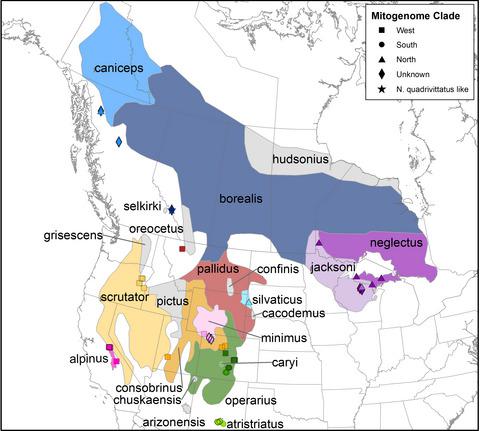当前位置:
X-MOL 学术
›
Ecol. Evol.
›
论文详情
Our official English website, www.x-mol.net, welcomes your
feedback! (Note: you will need to create a separate account there.)
Phylogeographic analysis delimits three evolutionary significant units of least chipmunks in North America and identifies unique genetic diversity within the imperiled Peñasco population
Ecology and Evolution ( IF 2.3 ) Pub Date : 2021-07-30 , DOI: 10.1002/ece3.7975 Emily E Puckett 1 , Sean M Murphy 2, 3 , Gideon Bradburd 4
Ecology and Evolution ( IF 2.3 ) Pub Date : 2021-07-30 , DOI: 10.1002/ece3.7975 Emily E Puckett 1 , Sean M Murphy 2, 3 , Gideon Bradburd 4
Affiliation

|
Although least chipmunks (Neotamias minimus) are a widely distributed North American species of least concern, the southernmost population, N. m. atristriatus (Peñasco least chipmunk), is imperiled and a candidate for federal listing as a subspecies. We conducted a phylogeographic analysis across the N. minimus range to assess genomic differentiation and distinctiveness of the N. m. atristriatus population. Additionally, we leveraged the historical component of sampling to conduct a temporal analysis of N. minimus genetic diversity and also considered climate change effects on range persistence probability by projecting a species distribution model into the IPCC5 RCP 2.6 and 8.5 scenarios. We identified three geographically structured groups (West, North, and South) that were supported by both mitochondrial and nuclear data. N. m. atristriatus grouped within a unique South subclade but were not reciprocally monophyletic from N. m. operarius, and nuclear genome analyses did not separate N. m. atristriatus, N. m. caryi, and N. m. operarius. Thus, while least chipmunks in the Southwest represent an evolutionary significant unit, subspecies distinctions were not supported and listing of the Peñasco population as a Distinct Population Segment of N. m. operarius may be warranted. Our results also support consideration of populations with North and West mitogenomes as two additional evolutionary significant units. We found that N. minimus genetic diversity declined by ~87% over the last century, and our models predicted substantial future habitat contraction, including the loss of the full contemporary ranges of N. m. atristriatus, N. m. arizonensis, and N. m. chuskaensis.
中文翻译:

系统发育地理学分析界定了北美最少花栗鼠的三个重要进化单位,并确定了濒临灭绝的佩尼亚斯科种群内独特的遗传多样性
虽然最小花栗鼠 ( Neotamias minimus ) 是一种分布广泛的北美物种,最不受关注,但最南端的花栗鼠种群N. m. atristriatus (佩尼亚斯科最小花栗鼠)处于危险之中,是联邦列为亚种的候选者。我们对极小猪笼草分布范围进行了系统发育地理学分析,以评估极小猪笼草的基因组分化和独特性。无纹状体种群。此外,我们利用采样的历史组成部分对微小猪笼草遗传多样性进行时间分析,并通过将物种分布模型投影到 IPCC5 RCP 2.6 和 8.5 情景中,考虑了气候变化对范围持续概率的影响。我们确定了三个地理结构群体(西部、北部和南部),它们得到了线粒体和核数据的支持。牛顿米atristriatus属于一个独特的南方支系,但与N. m.并不互为单系。 operarius和核基因组分析并未将N. m.分离出来。黑垂体卡伊和N.m。歌剧。因此,虽然西南部的花栗鼠代表了一个重要的进化单位,但不支持亚种区分,并将佩尼亚斯科种群列为新花栗鼠的一个独特种群部分。歌剧可能是有道理的。我们的结果还支持将具有北部和西部线粒体基因组的群体视为两个额外的重要进化单位。我们发现N.上个世纪,极小海藻的遗传多样性下降了约 87%,我们的模型预测未来栖息地将大幅收缩,包括现代海藻的全部分布范围的丧失。黑垂体亚利桑那州, 和N. m.楚斯卡人。
更新日期:2021-09-09
中文翻译:

系统发育地理学分析界定了北美最少花栗鼠的三个重要进化单位,并确定了濒临灭绝的佩尼亚斯科种群内独特的遗传多样性
虽然最小花栗鼠 ( Neotamias minimus ) 是一种分布广泛的北美物种,最不受关注,但最南端的花栗鼠种群N. m. atristriatus (佩尼亚斯科最小花栗鼠)处于危险之中,是联邦列为亚种的候选者。我们对极小猪笼草分布范围进行了系统发育地理学分析,以评估极小猪笼草的基因组分化和独特性。无纹状体种群。此外,我们利用采样的历史组成部分对微小猪笼草遗传多样性进行时间分析,并通过将物种分布模型投影到 IPCC5 RCP 2.6 和 8.5 情景中,考虑了气候变化对范围持续概率的影响。我们确定了三个地理结构群体(西部、北部和南部),它们得到了线粒体和核数据的支持。牛顿米atristriatus属于一个独特的南方支系,但与N. m.并不互为单系。 operarius和核基因组分析并未将N. m.分离出来。黑垂体卡伊和N.m。歌剧。因此,虽然西南部的花栗鼠代表了一个重要的进化单位,但不支持亚种区分,并将佩尼亚斯科种群列为新花栗鼠的一个独特种群部分。歌剧可能是有道理的。我们的结果还支持将具有北部和西部线粒体基因组的群体视为两个额外的重要进化单位。我们发现N.上个世纪,极小海藻的遗传多样性下降了约 87%,我们的模型预测未来栖息地将大幅收缩,包括现代海藻的全部分布范围的丧失。黑垂体亚利桑那州, 和N. m.楚斯卡人。











































 京公网安备 11010802027423号
京公网安备 11010802027423号